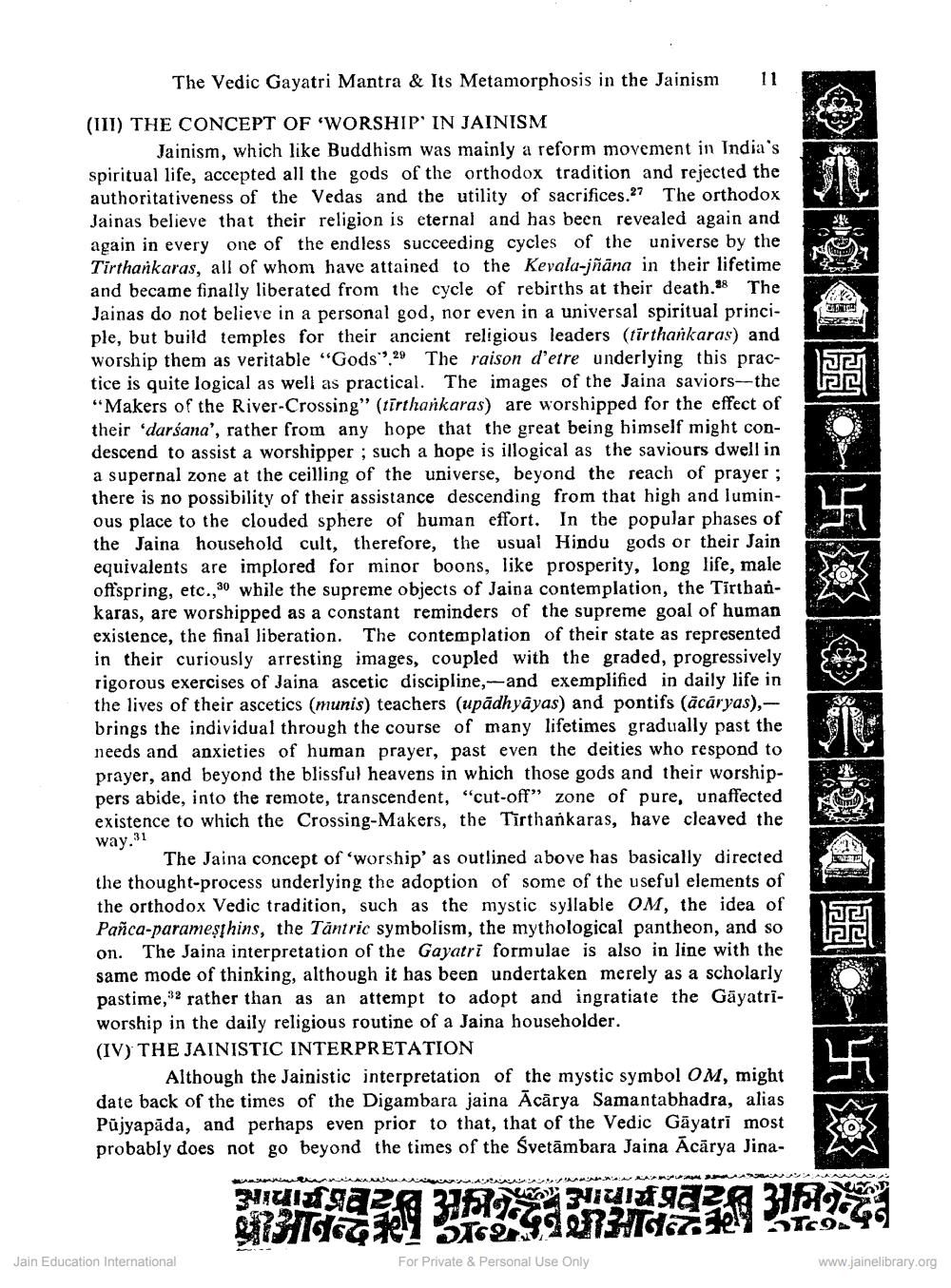________________
The Vedic Gayatri Mantra & Its Metamorphosis in the Jainism
:.
CERT ES
rn
(111) THE CONCEPT OF WORSHIP' IN JAINISM
Jainism, which like Buddhism was mainly a reform movement in India's spiritual life, accepted all the gods of the orthodox tradition and rejected the authoritativeness of the Vedas and the utility of sacrifices.27 The orthodox Jainas believe that their religion is eternal and has been revealed again and again in every one of the endless succeeding cycles of the universe by the Tirtharkaras, all of whom have attained to the Kevala-jñäna in their lifetime and became finally liberated from the cycle of rebirths at their death.28 The Jainas do not believe in a personal god, nor even in a universal spiritual principle, but build temples for their ancient religious leaders (tirthankaras) and worship them as veritable "Gods.29 The raison d'etre underlying this practice is quite logical as well as practical. The images of the Jaina saviors--the "Makers of the River Crossing" (tirtharkaras) are worshipped for the effect of their 'darśana', rather from any hope that the great being himself might condescend to assist a worshipper ; such a hope is illogical as the saviours dwell in a supernal zone at the ceilling of the universe, beyond the reach of prayer; there is no possibility of their assistance descending from that high and luminous place to the clouded sphere of human effort. In the popular phases of the Jaina household cult, therefore, the usual Hindu gods or their Jain equivalents are implored for minor boons, like prosperity, long life, male offspring, etc.,30 while the supreme objects of Jaina contemplation, the Tirthankaras, are worshipped as a constant reminders of the supreme goal of human existence, the final liberation. The contemplation of their state as represented in their curiously arresting images, coupled with the graded, progressively rigorous exercises of Jaina ascetic discipline,--and exemplified in daily life in the lives of their ascetics (munis) teachers (upādhyâyas) and pontifs (ācāryas),brings the individual through the course of many lifetimes gradually past the needs and anxieties of human prayer, past even the deities who respond to prayer, and beyond the blissful heavens in which those gods and their worshippers abide, into the remote, transcendent, "cut-off” zone of pure, unaffected existence to which the Crossing-Makers, the Tirthankaras, have cleaved the way.31
The Jaina concept of 'worship'as outlined above has basically directed the thought-process underlying the adoption of some of the useful elements of the orthodox Vedic tradition, such as the mystic syllable OM, the idea of Pañca-parameșjhins, the Tantric symbolism, the mythological pantheon, and so on. The Jaina interpretation of the Gayatri formulae is also in line with the same mode of thinking, although it has been undertaken merely as a scholarly pastime,rather than as an attempt to adopt and ingratiate the Gāyatriworship in the daily religious routine of a Jaina householder. (IV) THE JAINISTIC INTERPRETATION
Although the Jainistic interpretation of the mystic symbol OM, might date back of the times of the Digambara jaina Acarya Samantabhadra, alias Pujyapāda, and perhaps even prior to that, that of the Vedic Gāyatri most probably does not go beyond the times of the Svetāmbara Jaina Ācārya Jina
WAAAAAAAAAAA
AAAA
AAAAAA
34urzf9427 E nguyi922 3 gioice 2016 Gala1 3349
Jain Education International
For Private & Personal Use Only
www.jainelibrary.org




